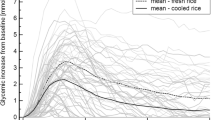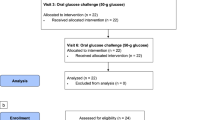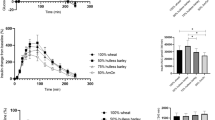Abstract
Objective: To study the influence of parboiling and the severity of the process on glycaemic and insulinaemic responses to rice in type 2 diabetes. Moreover, to examine changes in starch structure related to parboiling, which may affect the metabolic responses and digestibility.
Design: Nine type 2 diabetic subjects ingested four test meals: white bread (WB) and three meals of cooked polished rice of the same variety being non-parboiled (NP), mildly traditionally parboiled (TP) and severely pressure parboiled (PP). The participants ingested the test meals (50 g available carbohydrates) on separate occasions after an overnight fast.
Setting: Outpatient clinic, Dept. Endocrinology and Metabolism, Aarhus University Hospital, Denmark.
Results: All three rice samples elicited lower postprandial plasma glucose response (NP: 335±43; TP: 274±53; PP: 231±37 mmol/1*180 min.; means±s.e.m.) than white bread (626±80; P<0.001), within rice samples PP tended to be lower than NP (P=0.07). The glycaemic indices were: NP: 55±5, TP: 46±8 and PP: 39±6, and lower for PP than NP (P<0.05). The insulin responses were similar for the three rice meals, which were all lower than that to white bread (P<0.001). Differential scanning calorimetry showed the presence of amylose–lipid complexes in all rice samples and of retrograded amylopectin in PP. Amylose retrogradation was not detected in any of the rice samples.
Conclusions: All rice test meals were low-glycaemic in type 2 diabetic subjects. There was no effect of TP on glycaemic index, whereas PP reduced the glycaemic index by almost 30% compared to NP.
Sponsorship: The Royal Veterinary and Agricultural University, Aarhus University Hospital, Danish International Development Assistance (DANIDA), Ministry of Foreign Affairs and the ‘Konsul Johannes Fogh-Nielsens og Fru Ella Fogh-Nielsens Legat’ foundation.
European Journal of Clinical Nurtition (2000) 54, 380–385
This is a preview of subscription content, access via your institution
Access options
Subscribe to this journal
Receive 12 print issues and online access
$259.00 per year
only $21.58 per issue
Buy this article
- Purchase on Springer Link
- Instant access to full article PDF
Prices may be subject to local taxes which are calculated during checkout
Similar content being viewed by others
Author information
Authors and Affiliations
Contributions
Contributors: HNL led the project and was involved in all parts of the study including conception of the hypothesis, data collection, statistical analyses, interpretation of the results and writing of the paper. OWR took part in patient management, data collection and interpretation of the results. KKAl took part in patient management and data collection. PHR performed the DSC analyses and interpretated these data. SKB was responsible for the selection of rice varieties, physico-chemical analyses on the rice and for the traditional parboiling process. IT, SHT and KH were involved in the project design and interpretation of results. All contributed to the preparation of the manuscript.
Guarantor: Hanne Nygaard Larsen.
Corresponding author
Rights and permissions
About this article
Cite this article
Larsen, H., Rasmussen, O., Rasmussen, P. et al. Glycaemic index of parboiled rice depends on the severity of processing: study in type 2 diabetic subjects. Eur J Clin Nutr 54, 380–385 (2000). https://doi.org/10.1038/sj.ejcn.1600969
Received:
Revised:
Accepted:
Published:
Issue Date:
DOI: https://doi.org/10.1038/sj.ejcn.1600969
Keywords
This article is cited by
-
Beneficial glycaemic effects of high-amylose barley bread compared to wheat bread in type 2 diabetes
European Journal of Clinical Nutrition (2023)
-
A perspective on the benefits of consumption of parboiled rice over brown rice for glycaemic control
European Journal of Nutrition (2022)
-
Finger millet porridges subjected to different processing conditions showed low glycemic index and variable efficacy on plasma antioxidant capacity of healthy adults
Food Production, Processing and Nutrition (2020)
-
Effect of parboiling methods on the physicochemical characteristics and glycemic index of rice varieties
Journal of Food Measurement and Characterization (2020)
-
Studies on in vitro bioavailability and starch hydrolysis in zinc fortified ready-to-eat parboiled rice (komal chawal)
Journal of Food Science and Technology (2019)



